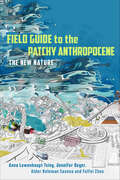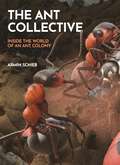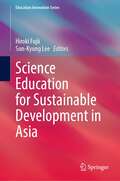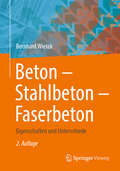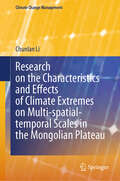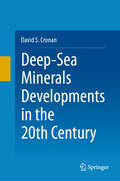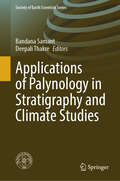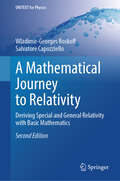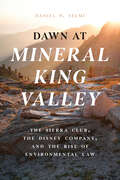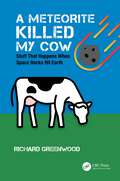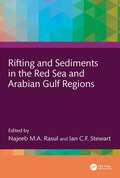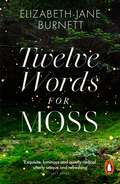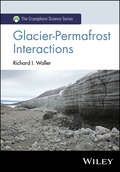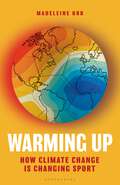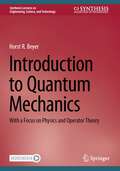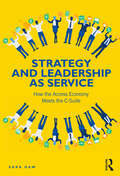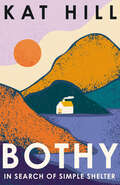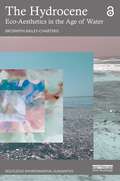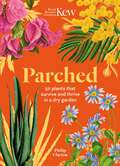- Table View
- List View
Field Guide to the Patchy Anthropocene: The New Nature
by Anna Lowenhaupt Tsing Jennifer Deger Alder Keleman Saxena Feifei ZhouNature has gone feral. How can we re-attune ourselves to the new nature? A field guide can help. While the global scientific community recently made headlines by ruling the Anthropocene—an era many date to the Industrial Revolution when human action truly began to transform the planet—did not qualify for a geological epoch quite yet, understanding the nature of human transformation of the Earth is more important than ever. The effects of human activity are global in scope, but take shape within distinct social and ecological "patches," discontinuous regions within which the key actors may not be human, but the plants, animals, fungi, viruses, plastics, and chemicals creating our new world. Field Guide to the Patchy Anthropocene takes stock of our current planetary crisis, leading readers through a series of sites, thought experiments, and genre-stretching descriptive practices to nurture a revitalized natural history. Field guides teach us how to notice, name, and so better appreciate more-than-human worlds. They hone our powers of observation and teach us to see the world anew. Field-based observations and place-based knowledge cultivation—getting up-close and personal with patchy dynamics—are vital to truly grapple with the ecological challenges and the historical conjunctures that are bringing us to multiple catastrophic tipping points. How has commercial agriculture runoff given rise to comb jellies in the Black Sea? What role did the Atlantic slave trade play in the worldwide spread of virus-carrying mosquitoes? How did the green revolution transform the brown planthopper into a superpredator in Philippine rice fields? Questions like these open up new ways of understanding, and ways of living through, the epoch that human activity has ushered in. This Field Guide shifts attention away from knowledge extractive practices of globalization to encourage skilled observers of many stripes to pursue their commitments to place, social justice, and multispecies community. It is through attention to the beings, places, ecologies, and histories of the Anthropocene that we can reignite curiosity, wonder, and care for our damaged planet.
The Ant Collective: Inside the World of an Ant Colony
by Armin SchiebAnts come alive on this fabulously illustrated journey into the heart of a bustling colonyAnts share a vibrant and complex communal life and remarkable abilities to communicate with each other. The Ant Collective presents the world of ants as you have never seen it before, using hyperrealistic, computer-generated imagery that shows 3D-like views of activities inside and outside a thriving nest of red wood ants. With chapters on topics ranging from the establishment and construction of the nest to the birth of an ant trail and the relocation of a colony, this one-of-a-kind book brilliantly integrates informative descriptions with the illustrations, drawing on the latest science to reveal the innermost workings of the colony and enabling you to explore the ant collective as if you are there.Features a wealth of naturalistic 3D-like illustrations and schematic infographicsDepicts the anatomy of ants, the architecture of their nests, their interactions with the environment and other animals, and their collective social behaviorFollows the annual life cycle of the colonyProvides an incredible up-close look at ant reproduction, defense, foraging, nesting, division of labor, and morePacked with information about the biology, ecology, and communication skills of these marvelous insects
Science Education for Sustainable Development in Asia (Education Innovation Series)
by Hiroki Fujii Sun-Kyung LeeThis book presents an Asian perspective on transformative science education in the context of the United Nations' Sustainable Development Goals (SDGs). The chapters are written by contributors who practiced science education for sustainability in a research project entitled “Teacher Education for ESD in the Asia-Pacific Region” from 2017 to 2019, supported by the Japan Society for the Promotion of Science, and the Japanese National Commission for UNESCO. The book showcases the contributors’ innovations in science education for sustainability, presenting case studies of science teaching and learning, science curriculum and assessment, science education in collaboration with local communities, and science teacher education. Embodying Asian sustainability education paradigms, policies, and practices, these case studies depict the diversity and uniqueness of natural, social, and cultural contexts in Asia, while demonstrating their commonalities. Through examining these case studies, this book aims to provide examples for praxis, and prospects, for new science classes, curricula, and teacher education in implementing education for sustainable development.
Beton – Stahlbeton – Faserbeton: Eigenschaften und Unterschiede
by Bernhard WietekBeton, Stahlbeton und Faserbeton sind Baustoffe, die nacheinander in großen Zeitabständen entwickelt wurden. Auf Grund ihrer unterschiedlichen Zusammensetzung haben sie voneinander sehr abweichende Eigenschaften, die bei jeder Anwendung auch berücksichtigt werden sollten. Diese müssen beobachtet und auch messtechnisch festgehalten werden, denn sie entscheiden über die Gebrauchszeit eines Bauwerkes. Gerade durch unterschiedliche Formen und auch Umwelteinflüsse wird diese Gebrauchszeit sehr stark beeinflusst. Es wird in einer abschließenden Tabelle dieser Zusammenhang aufgezeigt.
Research on the Characteristics and Effects of Climate Extremes on Multi-spatial-temporal Scales in the Mongolian Plateau (Climate Change Management)
by Chunlan LiCompared with average climate changes, climate extremes which are considered as low-probability events have greater impacts on natural and social systems due to their suddenness, unpredictability and strong destructiveness. Located in the typical arid–semiarid climate transition zone, the Mongolian Plateau, dominated by herbage animal husbandry, is greatly affected by climate extremes, and its ecosystem is extremely fragile. In the context of global warming, the spatial-temporal variation research about climate extremes and their impacts on vegetation is not only beneficial to the protection of the grassland ecological environment in the Mongolian Plateau, but also of great significance to formulate an effective meteorological disaster risk management.Based on daily highest temperature, daily minimum temperature and daily precipitation dataset of 111 meteorological stations over Mongolian Plateau from 1961 to 2014. Firstly, sixteen extreme temperature indices and eleven extreme precipitation indices were calculated. Then, multi-spatial-temporal characteristics of climate extremes in the scope of intensity, duration and frequency were analyzed. At the same time, the vegetation variations were analyzed based on GIMMS NDVI3g data. Thirdly, correlation analysis and multiple stepwise regression analysis were used to analyze the relationships between extreme climate indices and NDVI in different spatial scales from the perspective of single factor and multiple factors, respectively. Finally, the future change of climate extremes in duration were explored based on the climate model data. At the same time, the vulnerable areas of grassland and forest were also identified, and adaptive options of different scales were proposed.Researchers engaged in extreme climate change and managers of government departments are the readership/primary audience for the work.
Deep-Sea Minerals Developments in the 20th Century
by David S. CronanThe book is an historical monograph on deep-sea mineral-related activities and attitudes towards deep-sea mining in the 20th Century which makes comparisons with the current situation in regard to those activities and attitudes. It reviews developments in the study of, and prospects and plans for mining deep-sea manganese nodules, cobalt-rich crusts, hydrothermal deposits, and phosphorites, and discusses associated environmental, technological, and economic issues. It is based on several sources. First, the author’s experience gleaned from around 50 years of attending conferences on the subject (the most important of which was the annual Underwater Mining Institutes held from 1970 onwards at which much of the material in the book was first exposed), second, discussions with and advice from the author's colleagues on the subject, all attributed, and third, the published literature. The target audiences are marine mining companies and their associates, marine environmentalists, UN and Government administrators responsible for seabed activities, undergraduate students of marine affairs and history, and interested lay persons. Unique features include the widespread sources used including unpublished conference proceedings and reports, personal insights gleaned from more than 50 years of working in the field, the author’s publications dating from 1967-2022, and attributed personal communications from the author’s colleagues.
Applications of Palynology in Stratigraphy and Climate Studies (Society of Earth Scientists Series)
by Bandana Samant Deepali ThakreThis book highlights the importance of palynology in understanding floral biodiversity, paleoclimate and depositional environments in deep time and recent sediments. It includes contributions from renowned Indian palynologists who work on the applied aspects of palynology. The book focuses on the significance of palynology in solving various geological problems, ranging from the Precambrian to the Recent. This book will be useful to graduate and postgraduate students, researchers, and academicians working in geology and botany, as well as international researchers interested in palynological research work in India.
A Mathematical Journey to Relativity: Deriving Special and General Relativity with Basic Mathematics (UNITEXT for Physics)
by Wladimir-Georges Boskoff Salvatore CapozzielloThe 2nd edition of this textbook features more than 100 pages of new material, including four new chapters, as well as an improved discussion of differential geometry concepts and their applications. The textbook aims to provide a comprehensive geometric description of Special and General Relativity, starting from basic Euclidean geometry to more advanced non-Euclidean geometry and differential geometry. Readers will learn about the Schwarzschild metric, the relativistic trajectory of planets, the deflection of light, the black holes, and the cosmological solutions like de Sitter, Friedman-Lemaître-Robertson-Walker, and Gödel ones, as well as the implications of each of them for the observed physical world. In addition, the book provides step-by-step solutions to problems and exercises, making it an ideal introduction for undergraduate students and readers looking to gain a better understanding of Special and General Relativity. In this new edition, a wide discussion on metric-affine theories of gravity and equivalent formulations of General Relativity is reported. The aim is presenting also topics which could be useful for PhD students and researchers studying General Relativity from an advanced point of view.
Dawn at Mineral King Valley: The Sierra Club, the Disney Company, and the Rise of Environmental Law
by Daniel P. SelmiThe story behind the historic Mineral King Valley case, which reveals how the Sierra Club battled Disney’s ski resort development and launched a new environmental era in America. In our current age of climate change–induced panic, it’s hard to imagine a time when private groups were not actively enforcing environmental protection laws in the courts. It wasn’t until 1972, however, that a David and Goliath–esque Supreme Court showdown involving the Sierra Club and Disney set a revolutionary legal precedent for the era of environmental activism we live in today. Set against the backdrop of the environmental movement that swept the country in the late 1960s and early 1970s, Dawn at Mineral King Valley tells the surprising story of how the US Forest Service, the Disney company, and the Sierra Club each struggled to adapt to the new, rapidly changing political landscape of environmental consciousness in postwar America. Proposed in 1965 and approved by the federal government in 1969, Disney’s vast development plan would have irreversibly altered the practically untouched Mineral King Valley, a magnificently beautiful alpine area in the Sierra Nevada mountains. At first, the plan met with unanimous approval from elected officials, government administrators, and the press—it seemed inevitable that this expanse of wild natural land would be radically changed and turned over to a private corporation. Then the scrappy Sierra Club forcefully pushed back with a lawsuit that ultimately propelled the modern environmental era by allowing interest groups to bring litigation against environmentally destructive projects. An expert on environmental law and appellate advocacy, Daniel P. Selmi uses his authoritative narrative voice to recount the complete history of this revolutionary legal battle and the ramifications that continue today, almost 50 years later.
A Meteorite Killed My Cow: Stuff That Happens When Space Rocks Hit Earth
by Richard GreenwoodMeteorites are generally considered to be bizarre and exotic space junk that you only ever come across in museums. But the reality is very different. Meteorites are generally harmless, with the exception of a cow in Venezuela and a few dinosaurs. Well, quite a few dinosaurs in fact! They are arriving on Earth every day, everywhere, in the form of fine dust. The result is that meteorites can be collected from the rooftops of houses everywhere. It’s not easy and you need to know what to look for. This book will help. Meteorites are the oldest rocks in our Solar System and contain grains that are even older. These space rocks provide science with the best available evidence concerning the origin and early evolution of the Solar System.This book introduces the reader to the fascinating and sometimes bizarre world of space rocks using a simple, clear layman-friendly style. It explains why they are so special and describes their main characteristics. The non-technical approach used throughout the book make it particularly accessible to the general public and it will be of interest to anyone looking to learn more about these cosmic visitors and the wealth of scientific information they contain.Features: Provides a concise introduction to the world of meteorites in an accessible and non-technical way Demonstrates how meteorites can be found locally and provides practical guidance on how to search for them! Emphasizes the human side of meteorites and how ordinary people can and do encounter meteorites in a wide variety of settings
A Meteorite Killed My Cow: Stuff That Happens When Space Rocks Hit Earth
by Richard GreenwoodMeteorites are generally considered to be bizarre and exotic space junk that you only ever come across in museums. But the reality is very different. Meteorites are generally harmless, with the exception of a cow in Venezuela and a few dinosaurs. Well, quite a few dinosaurs in fact! They are arriving on Earth every day, everywhere, in the form of fine dust. The result is that meteorites can be collected from the rooftops of houses everywhere. It’s not easy and you need to know what to look for. This book will help. Meteorites are the oldest rocks in our Solar System and contain grains that are even older. These space rocks provide science with the best available evidence concerning the origin and early evolution of the Solar System.This book introduces the reader to the fascinating and sometimes bizarre world of space rocks using a simple, clear layman-friendly style. It explains why they are so special and describes their main characteristics. The non-technical approach used throughout the book make it particularly accessible to the general public and it will be of interest to anyone looking to learn more about these cosmic visitors and the wealth of scientific information they contain.Features: Provides a concise introduction to the world of meteorites in an accessible and non-technical way Demonstrates how meteorites can be found locally and provides practical guidance on how to search for them! Emphasizes the human side of meteorites and how ordinary people can and do encounter meteorites in a wide variety of settings
Rifting and Sediments in the Red Sea and Arabian Gulf Regions
by Najeeb M.A. Rasul Ian C.F. StewartRifting and Sediments in the Red Sea and Arabian Gulf Regions is a unique text that covers a wide range of topics related to the tectonics and geology of the Red Sea and Arabian (Persian) Gulf region. This book is a collection of invited and peer-reviewed chapters contributed by active researchers around the world.The topics covered in this book include tectonics, magmatism, and lithology, particularly in the Red Sea area. The book also delves into the sediments and evaporites of the Red Sea and Gulf. As the area around the Arabian Peninsula is prone to earthquakes, the seismic hazard estimated in the Red Sea region is also covered by several chapters. Each chapter presents new data and offers extensive lists of references for the reader to explore further.With the ongoing debates regarding the structure of the Red Sea, this book serves as an excellent resource for researchers and any individuals interested in the geology of these two unique seas.
Rifting and Sediments in the Red Sea and Arabian Gulf Regions
Rifting and Sediments in the Red Sea and Arabian Gulf Regions is a unique text that covers a wide range of topics related to the tectonics and geology of the Red Sea and Arabian (Persian) Gulf region. This book is a collection of invited and peer-reviewed chapters contributed by active researchers around the world.The topics covered in this book include tectonics, magmatism, and lithology, particularly in the Red Sea area. The book also delves into the sediments and evaporites of the Red Sea and Gulf. As the area around the Arabian Peninsula is prone to earthquakes, the seismic hazard estimated in the Red Sea region is also covered by several chapters. Each chapter presents new data and offers extensive lists of references for the reader to explore further.With the ongoing debates regarding the structure of the Red Sea, this book serves as an excellent resource for researchers and any individuals interested in the geology of these two unique seas.
Twelve Words for Moss: Love, Loss And Moss
by Elizabeth-Jane BurnettSHORTLISTED FOR THE JHALAK PRIZE 2024Shortlisted for the Wainwright Prize 2023 for Nature Writing'Exquisite, luminous and quietly radical . . . utterly unique and refreshing' Lucy JonesWhere nothing grows, moss is the spark that triggers new life. Embarking on a journey though landscape, memory and recovery, Elizabeth-Jane Burnett explores this mysterious, ancient marvel of the plant world, meditating on and renaming her favourite mosses – from Glowflake to Little Loss – and drawing inspiration from place, people and language itself. 'Fascinating, subtle and risk-taking . . . Poetry, descriptive-evocative prose, memory, memoir, natural history and more all drift and mingle in strikingly new ways' Robert Macfarlane
Glacier-Permafrost Interactions (The Cryosphere Science Series)
by Richard I. WallerGlacier-Permafrost Interactions A systematic exploration of the interactions between glaciers and permafrost In Glacier-Permafrost Interactions, experienced glaciologist Richard I. Waller delivers a comprehensive discussion of the interactions between glaciers and permafrost. The book is highly relevant to contemporary debates regarding ongoing recession of glaciers and the degradation of permafrost in the face of global warming. By integrating modern-era observations with findings from Quaternary science, this book demonstrates how glaciers and permafrost can interact and behave as an integrated system. This summary of the current thinking and emerging research on glacier-permafrost interaction also provides: Comprehensive discussions of permafrost in modern and ancient glacial environments A focused review of the distinctive characteristics of glaciers found in permafrost environments An integrated overview of the nature and impacts of glacier-permafrost interactions on the hydrology and dynamic behaviour of glaciers and their landscape expression A survey of current research efforts and future directions in the field Lying at the boundary between a research monograph and an advanced textbook, Glacier-Permafrost Interactions contributes to the future development of this rapidly evolving field by incorporating new approaches and ideas while still offering a summary of the current state of knowledge. It is perfect for advanced undergraduate students, postgraduate students, researchers, and professionals with an interest in polar and alpine environments.
Glacier-Permafrost Interactions (The Cryosphere Science Series)
by Richard I. WallerGlacier-Permafrost Interactions A systematic exploration of the interactions between glaciers and permafrost In Glacier-Permafrost Interactions, experienced glaciologist Richard I. Waller delivers a comprehensive discussion of the interactions between glaciers and permafrost. The book is highly relevant to contemporary debates regarding ongoing recession of glaciers and the degradation of permafrost in the face of global warming. By integrating modern-era observations with findings from Quaternary science, this book demonstrates how glaciers and permafrost can interact and behave as an integrated system. This summary of the current thinking and emerging research on glacier-permafrost interaction also provides: Comprehensive discussions of permafrost in modern and ancient glacial environments A focused review of the distinctive characteristics of glaciers found in permafrost environments An integrated overview of the nature and impacts of glacier-permafrost interactions on the hydrology and dynamic behaviour of glaciers and their landscape expression A survey of current research efforts and future directions in the field Lying at the boundary between a research monograph and an advanced textbook, Glacier-Permafrost Interactions contributes to the future development of this rapidly evolving field by incorporating new approaches and ideas while still offering a summary of the current state of knowledge. It is perfect for advanced undergraduate students, postgraduate students, researchers, and professionals with an interest in polar and alpine environments.
Warming Up: How Climate Change is Changing Sport
by Madeleine OrrThe world of sport has a new opponent: climate change.In recent years, a world championship marathon was held at midnight to avoid the blistering sun. Professional athletes needed oxygen tanks to play during wildfire season in California. Players collapsed and play was suspended amid the heat and bushfire smoke at the Australian Tennis open. Ski resorts in the Alps have turned into ghost towns. Golf courses are sinking into the sea. And then there's the Qatar World Cup, among the greatest follies in sporting history, one that saw hundreds (perhaps thousands) of heat-induced deaths before a ball was even kicked. The threat climate change poses to sport is clear, but with billions of participants and fans around the world who rely on the sector for entertainment, jobs, fitness and health, this is one industry we can't afford to lose. In this book, Madeleine Orr shows it doesn't have to be this way. There are ways to mitigate, and perhaps counter, even the worst elements of climate change. A world-leading sport ecologist, Madeleine interviews athletes, coaches, politicians and thought-leaders to learn more about the inevitable consequences for this trillion-dollar industry. From the frontlines of climate change, Warming Up takes readers through a play-by-play of how global warming is already impacting sport, and how the sports world can fight back.
Warming Up: How Climate Change is Changing Sport
by Madeleine OrrThe world of sport has a new opponent: climate change.In recent years, a world championship marathon was held at midnight to avoid the blistering sun. Professional athletes needed oxygen tanks to play during wildfire season in California. Players collapsed and play was suspended amid the heat and bushfire smoke at the Australian Tennis open. Ski resorts in the Alps have turned into ghost towns. Golf courses are sinking into the sea. And then there's the Qatar World Cup, among the greatest follies in sporting history, one that saw hundreds (perhaps thousands) of heat-induced deaths before a ball was even kicked. The threat climate change poses to sport is clear, but with billions of participants and fans around the world who rely on the sector for entertainment, jobs, fitness and health, this is one industry we can't afford to lose. In this book, Madeleine Orr shows it doesn't have to be this way. There are ways to mitigate, and perhaps counter, even the worst elements of climate change. A world-leading sport ecologist, Madeleine interviews athletes, coaches, politicians and thought-leaders to learn more about the inevitable consequences for this trillion-dollar industry. From the frontlines of climate change, Warming Up takes readers through a play-by-play of how global warming is already impacting sport, and how the sports world can fight back.
Introduction to Quantum Mechanics: With a Focus on Physics and Operator Theory (Synthesis Lectures on Engineering, Science, and Technology)
by Horst R. BeyerThis book presents an introduction to quantum mechanics that consistently uses the methods of operator theory, allowing readers to develop a physical understanding of quantum mechanical systems. The methods of operator theory are discussed throughout the book and presented with a mathematically rigorous approach. The author describes in detail how to use the methods of operator theory for analyzing quantum mechanical systems, starting with the definition of the involved physical operators (observables) up to the calculation of their spectra, spectral measures, and functional calculus. In addition, the book includes the construction of exponential functions of the involved Hamilton operators that solve the problem of time evolution.
Strategy and Leadership as Service: How the Access Economy Meets the C-Suite
by Sara DawStrategy and Leadership as Service isn’t just a nice idea; it is a practical, alternative vision of the future of work for senior executives that is starting to gain significant interest and is being adopted by businesses globally. Disrupting and challenging the traditional full-time employment model, the Strategy and Leadership as Service framework provides businesses with access to the complete range of functional, emotional, and collective intelligence at the C-suite level by moving their positions from the “pay-roll” to an “access-role.”Many entrepreneurial and growing businesses don’t need, don’t want, and can’t afford full-time C-suite executives. For larger organisations, it is becoming harder to find the skills and knowledge required to fulfil all the obligations of a functional C-suite with a fixed group of individuals. By moving to the Strategy and Leadership as Service framework, the outcomes are better for all stakeholders: more engagement, access to the right skillsets and mindsets at the right time and in the right quantity to match the changing business agenda, more flexibility for senior leaders, and strengthened risk management. Through presenting a working business model, and real-world case studies throughout, this book provides executives and leaders with a complete understanding of this ground-breaking approach and its key benefits, the theory upon which it is based, its essential ingredients, the mindset change required and, most importantly, how to apply it in practice.The book provides business leaders, C-suite portfolio executives, human resource professionals, strategy consultants, leadership coaches, organisational development consultants, recruiters, professional service firms, academics, and forward-thinking business students with a radical new view of how the access economy can be applied to business strategy and leadership for more sustainable futures.
Strategy and Leadership as Service: How the Access Economy Meets the C-Suite
by Sara DawStrategy and Leadership as Service isn’t just a nice idea; it is a practical, alternative vision of the future of work for senior executives that is starting to gain significant interest and is being adopted by businesses globally. Disrupting and challenging the traditional full-time employment model, the Strategy and Leadership as Service framework provides businesses with access to the complete range of functional, emotional, and collective intelligence at the C-suite level by moving their positions from the “pay-roll” to an “access-role.”Many entrepreneurial and growing businesses don’t need, don’t want, and can’t afford full-time C-suite executives. For larger organisations, it is becoming harder to find the skills and knowledge required to fulfil all the obligations of a functional C-suite with a fixed group of individuals. By moving to the Strategy and Leadership as Service framework, the outcomes are better for all stakeholders: more engagement, access to the right skillsets and mindsets at the right time and in the right quantity to match the changing business agenda, more flexibility for senior leaders, and strengthened risk management. Through presenting a working business model, and real-world case studies throughout, this book provides executives and leaders with a complete understanding of this ground-breaking approach and its key benefits, the theory upon which it is based, its essential ingredients, the mindset change required and, most importantly, how to apply it in practice.The book provides business leaders, C-suite portfolio executives, human resource professionals, strategy consultants, leadership coaches, organisational development consultants, recruiters, professional service firms, academics, and forward-thinking business students with a radical new view of how the access economy can be applied to business strategy and leadership for more sustainable futures.
Bothy: In Search of Simple Shelter
by null Kat Hill‘The bothy embrace is addictive’ ADAM NICOLSON 'Will have you reaching for your boots’ CAL FLYN The door to the bothy is always unlocked, you just need to step inside. You will find them in the mountains. You will find them in the wilderness. A bothy is a remote hut you can’t reserve, with no electricity, mod-cons or running water. And it’s here you’ll find Kat Hill – kettle on, feet up and pen out. Leading us on a gorgeous and erudite journey around the UK, Kat reveals the history of these wild mountain shelters and the people who visit them. With a historian’s insight and a rambler’s imagination, she lends fresh consideration to the concepts of nature, wilderness and escape. All the while, Kat weaves together her story of heartbreak and new purpose with those of her fellow wanderers, past and present. Writing with warmth, wit and infectious wanderlust, Kat moves from a hut in an active military training area in the far-north of Scotland to a fairy-tale cottage in Wales. Along her travels, she explores the conflict between our desire to preserve isolated beauty and the urge to share it with others – embodied by the humble bothy. Bothy is a stirring, beautiful book for anyone who longs to run away to the wilds.
The Hydrocene: Eco-Aesthetics in the Age of Water (ISSN)
by Bronwyn Bailey-CharterisThis book challenges conventional notions of the Anthropocene and champions the Hydrocene: the Age of Water. It presents the Hydrocene as a disruptive, conceptual epoch and curatorial theory, emphasising water's pivotal role in the climate crisis and contemporary art.The Hydrocene is a wet ontological shift in eco-aesthetics which redefines our approach to water, transcending anthropocentric, neo-colonial and environmentally destructive ways of relating to water. As the most fundamental of elements, water has become increasingly politicised, threatened and challenged by the climate crisis. In response, The Hydrocene articulates and embodies the distinctive ways contemporary artists relate and engage with water, offering valuable lessons towards climate action. Through five compelling case studies across swamp, river, ocean, fog and ice, this book binds feminist environmental humanities theories with the practices of eco-visionary artists. Focusing on Nordic and Oceanic water-based artworks, it demonstrates how art can disrupt established human–water dynamics. By engaging hydrofeminist, care-based and planetary thinking, The Hydrocene learns from the knowledge and agency of water itself within the tide of art going into the blue.The Hydrocene urgently highlights the transformative power of eco-visionary artists in reshaping human–water relations. At the confluence of contemporary art, curatorial theory, climate concerns and environmental humanities, this book is essential reading for researchers, curators, artists, students and those seeking to reconsider their connection with water and advocate for climate justice amid the ongoing natural-cultural water crisis.The Open Access version of this book, available at http://www.taylorfrancis.com, has been made available under a Creative Commons Attribution-Non Commercial-No Derivatives (CC-BY-NC-ND) 4.0 license.
The Hydrocene: Eco-Aesthetics in the Age of Water (ISSN)
by Bronwyn Bailey-CharterisThis book challenges conventional notions of the Anthropocene and champions the Hydrocene: the Age of Water. It presents the Hydrocene as a disruptive, conceptual epoch and curatorial theory, emphasising water's pivotal role in the climate crisis and contemporary art.The Hydrocene is a wet ontological shift in eco-aesthetics which redefines our approach to water, transcending anthropocentric, neo-colonial and environmentally destructive ways of relating to water. As the most fundamental of elements, water has become increasingly politicised, threatened and challenged by the climate crisis. In response, The Hydrocene articulates and embodies the distinctive ways contemporary artists relate and engage with water, offering valuable lessons towards climate action. Through five compelling case studies across swamp, river, ocean, fog and ice, this book binds feminist environmental humanities theories with the practices of eco-visionary artists. Focusing on Nordic and Oceanic water-based artworks, it demonstrates how art can disrupt established human–water dynamics. By engaging hydrofeminist, care-based and planetary thinking, The Hydrocene learns from the knowledge and agency of water itself within the tide of art going into the blue.The Hydrocene urgently highlights the transformative power of eco-visionary artists in reshaping human–water relations. At the confluence of contemporary art, curatorial theory, climate concerns and environmental humanities, this book is essential reading for researchers, curators, artists, students and those seeking to reconsider their connection with water and advocate for climate justice amid the ongoing natural-cultural water crisis.The Open Access version of this book, available at http://www.taylorfrancis.com, has been made available under a Creative Commons Attribution-Non Commercial-No Derivatives (CC-BY-NC-ND) 4.0 license.
Kew - Parched: 50 plants that thrive and survive in a dry garden
by Philip ClaytonDazzling, diverse, durable - discover the remarkable drought-proof plants that flourish in the driest environments.With rainfall unpredictable and summers increasingly hot, plants that survive and thrive in these conditions have become more important than ever. Through expert text and beautiful botanical illustrations from the archives of the Royal Botanic Gardens, Kew, Parched explores the captivating variety that exists in the world of dry plants. From poppies and palms to cypress and cyclamen, this stunning book showcases the incredible species that have become a mainstay of dry gardens around the world.
